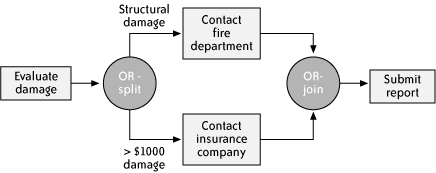Name
Advanced Branch and Join Patterns
Synopsis
The majority of BPM products and specifications support the basic and/or-split/join patterns described in the “Basic Patterns” section. Less well supported, but equally important, are the advanced branch and join patterns described in this section. The P4 has identified four patterns in this category: Multi-Choice, Synchronizing Merge, Multi-Merge, and the Discriminator and N-out-of-M-Join.
Multi-Choice
The intent of the Multi-Choice pattern is to choose one or more parallel branches, in which each branch is taken only if it satisfies a particular condition. The pattern is also known as Inclusive OR-split.
The Multi-Choice pattern describes the forking of a process to multiple branches where each fork is based on a condition that is known only at runtime. Multi-Choice is sometimes known as the OR-split; it differs from the Exclusive Choice pattern considered earlier, which is also known as the exclusive-OR- or XOR-split, by allowing more than one path to be spawned; exclusive choice selects exactly one direction. The P4 example, shown in Figure 4-6, describes the actions required in the aftermath of a building fire.
 |
Either the insurance company or the fire department, or both, must be contacted. The choice is based on conditions specific to the fire; ...
Get Essential Business Process Modeling now with the O’Reilly learning platform.
O’Reilly members experience books, live events, courses curated by job role, and more from O’Reilly and nearly 200 top publishers.

